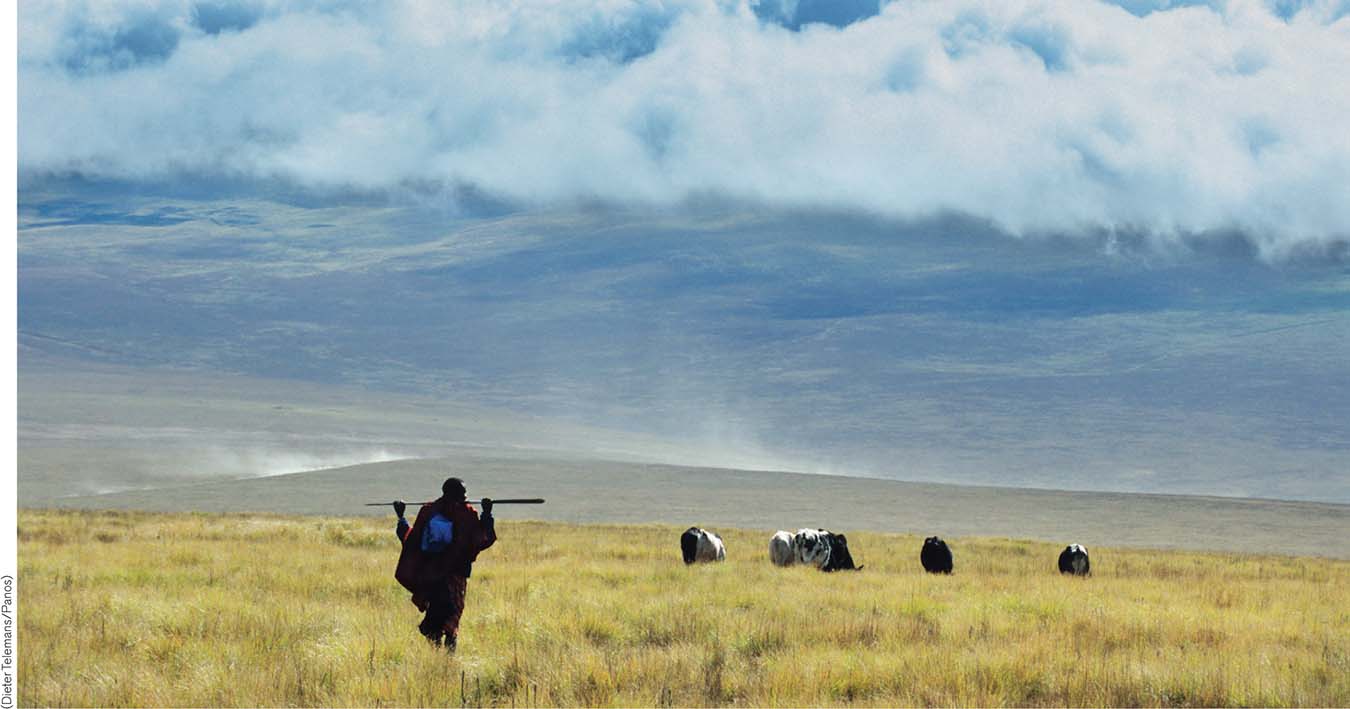Chapter Introduction
CHAPTER 2
Ecosystems and Economic Systems

Central Question: How can linking ecology and economics help reduce societies’ environmental impacts?
 SCIENCE
SCIENCE
Explain the nature and movement of matter and energy in ecosystems and economic systems.
 ISSUES
ISSUES
Analyze the environmental significance of energy demand, economic models, and the Tragedy of the Commons.
 SOLUTIONS
SOLUTIONS
Discuss how linking environment to economics, property rights, and community-
The Maasai People and the Economy of Nature
The Maasai way of life in the savannah ecosystem developed into a web of economic relations.

Life on the grassy plains of East Africa, considered the birthplace of humanity, changed dramatically when domesticated cattle arrived. In the 15th or 16th century, the Maasai people—
Cattle, in other words, were prominent in the material culture of East Africa. For thousands of generations, humans in the region had survived by hunting wild antelope, and gathering fruits and nuts. But with cattle, the Maasai significantly modified life on the plains to better provide for their needs. This new stability allowed them to develop a complex society that included procedures for decision making by councils of experienced elders, division of labor, trade within their own and neighboring cultures, and a military system for defending their resources. For instance, the Maasai negotiated with neighboring people to allow movement of their herds in time of drought; Maasai women traded excess milk, meat, and skins for bananas, maize, and sweet potatoes grown by farming neightbors.
“We must put the ‘eco’ back into economics and realise what the conditions and principles are for true sustainable living.”
David Suzuki, “The Challenge of the 21st Century: Setting the Real Bottom Line,” 2008
economic system A network of people, institutions, and commercial interests involved in the production, distribution, and consumption of goods and services.
As material culture developed, the Maasai joined with farmers and hunters in the area via an economic system. An economic system consists of a network of people, institutions, and commercial interests involved in the production, distribution, and consumption of goods and services. These principles apply to cattle trading and modern wealth economies alike.
The Maasai livelihood continued to depend on climate and the condition of the soil, but it was also shaped by these social innovations. It turns out, there is a surprising similarity between how natural environments function and the modern economic systems that sprang from human civilization. Ernst Haeckel, who coined the term ecology in the 19th century, said, “By ecology we mean the body of knowledge concerning the economy of nature.” We might also think of economics as the ecology of humans. Understanding the connection between economics and ecosystems is one of the key ways that environmental science allows us to find solutions to global challenges.
sustainable development A process of development that meets the needs of the present generation without reducing the ability of future generations to meet their needs. Development is sustainable when it does not, at a minimum, endanger Earth’s natural life support system, including the atmosphere, waters, soils, and biological diversity.
Though a modern economy may seem far different from that of the traditional Maasai, the differences result mainly from the level of technological development, the diversity of goods and services being traded, and the sheer amount of goods changing hands every day. Beyond those differences, however, our challenge, like that of the traditional Maasai and their neighbors, is the same: to sustain the healthy economies needed for thriving human societies while protecting the environment on which we depend for survival. This goal is generally referred to as sustainable development, development that meets the needs of the present generation without reducing the ability of future generations to meet their needs. This chapter’s Central Question reflects the core of that challenge.
Central Question
How can linking ecology and economics help reduce societies’ environmental impacts?